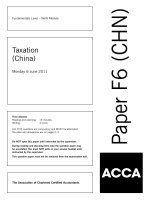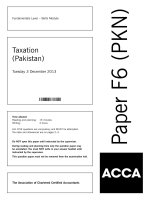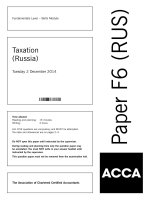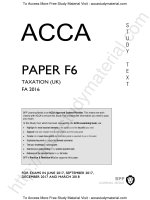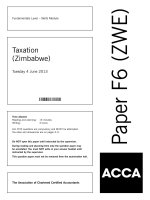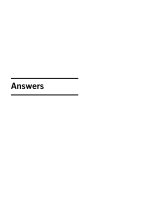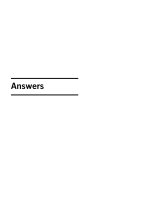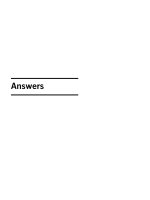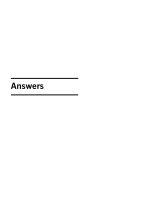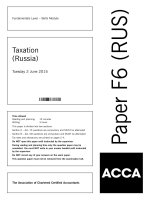ACCA f6 taxation uk 2014 jun question
Bạn đang xem bản rút gọn của tài liệu. Xem và tải ngay bản đầy đủ của tài liệu tại đây (314.59 KB, 14 trang )
Taxation
(United Kingdom)
Tuesday 3 June 2014
Time allowed
Reading and planning:
Writing:
15 minutes
3 hours
ALL FIVE questions are compulsory and MUST be attempted.
Rates of tax and tables are printed on pages 2–5.
Do NOT open this paper until instructed by the supervisor.
During reading and planning time only the question paper may
be annotated. You must NOT write in your answer booklet until
instructed by the supervisor.
This question paper must not be removed from the examination hall.
The Association of Chartered Certified Accountants
Paper F6 (UK)
Fundamentals Level – Skills Module
SUPPLEMENTARY INSTRUCTIONS
1.
2.
3.
Calculations and workings need only be made to the nearest £.
All apportionments should be made to the nearest month.
All workings should be shown.
TAX RATES AND ALLOWANCES
The following tax rates and allowances are to be used in answering the questions.
Income tax
Basic rate
Higher rate
Additional rate
£1 – £32,010
£32,011 – £150,000
£150,001 and over
Normal
rates
%
20
40
45
Dividend
rates
%
10
32·5
37·5
A starting rate of 10% applies to savings income where it falls within the first £2,790 of taxable income.
Personal allowance
Personal allowance
Born on or after 6 April 1948
Born between 6 April 1938 and 5 April 1948
Born before 6 April 1938
£9,440
£10,500
£10,660
Income limit
Personal allowance
Personal allowance (born before 6 April 1948)
£100,000
£26,100
Residence status
Days in UK
Less than 16
16 to 45
46 to 90
91 to 120
121 to 182
183 or more
Previously resident
Automatically not resident
Resident if 4 UK ties (or more)
Resident if 3 UK ties (or more)
Resident if 2 UK ties (or more)
Resident if 1 UK tie (or more)
Automatically resident
Not previously resident
Automatically not resident
Automatically not resident
Resident if 4 UK ties
Resident if 3 UK ties (or more)
Resident if 2 UK ties (or more)
Automatically resident
Child benefit income tax charge
Where income is between £50,000 and £60,000, the charge is 1% of the amount of child benefit received for every
£100 of income over £50,000.
2
Car benefit percentage
The relevant base level of CO2 emissions is 95 grams per kilometre.
The percentage rates applying to petrol cars with CO2 emissions up to this level are:
5%
10%
11%
75 grams per kilometre or less
76 grams to 94 grams per kilometre
95 grams per kilometre
Car fuel benefit
The base figure for calculating the car fuel benefit is £21,100.
Individual savings accounts (ISAs)
The overall investment limit is £11,520, of which £5,760 can be invested in a cash ISA.
Pension scheme limit
Annual allowance
£50,000
The maximum contribution that can qualify for tax relief without any earnings is £3,600.
Authorised mileage allowances: cars
Up to 10,000 miles
Over 10,000 miles
45p
25p
Capital allowances: rates of allowance
%
Plant and machinery
Main pool
Special rate pool
18
8
Motor cars
New cars with CO2 emissions up to 95 grams per kilometre
CO2 emissions between 96 and 130 grams per kilometre
CO2 emissions over 130 grams per kilometre
100
18
8
Annual investment allowance
First £250,000 of expenditure (since 1 January 2013)
100
Cap on income tax reliefs
Unless otherwise restricted, reliefs are capped at the higher of £50,000 or 25% of income.
3
[P.T.O.
Corporation tax
Financial year
Small profits rate
Main rate
Lower limit
Upper limit
Standard fraction
2011
20%
26%
2012
20%
24%
2013
20%
23%
£300,000
£1,500,000
£300,000
£1,500,000
£300,000
£1,500,000
3/200
1/100
3/400
Marginal relief
Standard fraction x (U – A) x N/A
Value added tax (VAT)
Standard rate
Registration limit
Deregistration limit
20%
£79,000
£77,000
Inheritance tax: tax rates
£1 – £325,000
Excess – Death rate
– Lifetime rate
Nil
40%
20%
Inheritance tax: taper relief
Years before death
Over
Over
Over
Over
3
4
5
6
but
but
but
but
less
less
less
less
than
than
than
than
4
5
6
7
Percentage
reduction
%
20
40
60
80
years
years
years
years
Capital gains tax
Rates of tax – Lower rate
– Higher rate
Annual exempt amount
Entrepreneurs’ relief – Lifetime limit
– Rate of tax
18%
28%
£10,900
£10,000,000
10%
4
National insurance contributions
(Not contracted out rates)
Class 1
Employee
£1 – £7,755 per year
£7,756 – £41,450 per year
£41,451 and above per year
%
Nil
12·0
12·0
Class 1
Employer
£1 – £7,696 per year
£7,697 and above per year
Nil
13·8
Class 1A
Class 2
Class 4
13·8
£2·70 per week
Small earnings exemption
£1 – £7,755 per year
£7,756 – £41,450 per year
£41,451 and above per year
£5,725
Nil
9·0
2·0
Rates of interest (assumed)
Official rate of interest
Rate of interest on underpaid tax
Rate of interest on overpaid tax
4·0%
3·0%
0·5%
5
[P.T.O.
ALL FIVE questions are compulsory and MUST be attempted
1
Richard Tryer was born on 22 June 1971. He is employed by Prog plc as a computer programmer, and is also
self-employed as a website designer. Richard has tried to prepare his own income tax computation for the tax year
2013–14, but he has found it more difficult than expected. Although the sections which Richard has completed are
correct, there are a significant number of omissions. The omissions are marked as outstanding (O/S). The partly
completed income tax computation is as follows:
Richard Tryer – Income tax computation 2013–14
Trading profit
Employment income
Salary
Car benefit
Fuel benefit
Living accommodation
Property business profit
Building society interest
Dividends
Note
1
2
2
3
£
41,000
O/S
O/S
O/S
–––––––
O/S
O/S
1,260
O/S
–––––––
O/S
(9,440)
–––––––
O/S
–––––––
4
Personal allowance
Taxable income
Income tax
32,010 at 20%
O/S at 40%
O/S at 32·5%
–––––––
O/S
–––––––
Income tax liability
Tax suffered at source
PAYE
Building society interest
Dividends
£
O/S
6,402
O/S
O/S
–––––––
O/S
9,130
O/S
180
–––––––
(O/S)
–––––––
O/S
–––––––
Income tax payable
Note 1 – Trading profit
Richard commenced self-employment on 1 January 2013. He had a tax adjusted trading profit of £3,840 for the
four-month period ended 30 April 2013, and £12,060 for the year ended 30 April 2014. These figures are before
taking account of capital allowances.
The only item of plant and machinery owned by Richard is his motor car, which cost £18,000 on 1 September 2013.
The motor car has a CO2 emission rate of 142 grams per kilometre, and 70% of the mileage driven by Richard is for
private journeys.
Note 2 – Car and fuel benefits
Throughout the tax year 2013–14, Prog plc provided Richard with a petrol-powered motor car which has a list price
of £17,900. The motor car cost Prog plc £17,200, and it has a CO2 emission rate of 144 grams per kilometre. During
the tax year 2013–14, Richard made contributions of £1,200 to Prog plc for the use of the motor car.
During the period 1 July 2013 to 5 April 2014, Prog plc also provided Richard with fuel for private journeys. The
total cost of fuel during the period 1 July 2013 to 5 April 2014 was £4,200, of which 45% was for private journeys.
Richard did not make any contributions towards the cost of the fuel.
6
Note 3 – Living accommodation
Throughout the tax year 2013–14, Prog plc provided Richard with living accommodation. The property has been
rented by Prog plc since 6 April 2013 at a cost of £1,100 per month. On 6 April 2013, the market value of the
property was £122,000, and it has an annual value of £8,600.
On 6 April 2013, Prog plc purchased furniture for the property at a cost of £12,100. The company pays for the
running costs relating to the property, and for the tax year 2013–14 these amounted to £3,700.
Note 4 – Property business profit
Richard owns a freehold shop which is let out unfurnished. The shop was purchased on 1 October 2013, and during
October 2013 Richard spent £8,400 replacing the building’s roof. The shop was not usable until this work was
carried out, and this fact was represented by a reduced purchase price. During November 2013, Richard spent £800
on advertising the property for rent.
On 1 December 2013, the property was let to a tenant, with Richard receiving a premium of £12,000 for the grant
of a 30-year lease. The monthly rent is £830 payable in advance, and during the period 1 December 2013 to 5 April
2014 Richard received five rental payments.
Due to a fire, £8,600 was spent on replacing the roof of the shop during February 2014. Only £8,200 of this was
paid for by Richard’s property insurance.
Richard paid insurance of £480 in respect of the property. This was paid on 1 October 2013 and is for the year ended
30 September 2014.
Other information
Richard did not make any personal pension contributions during the tax year 2013–14. He has never been a member
of a pension scheme.
Required:
(a) Calculate the income tax payable by Richard Tryer for the tax year 2013–14.
(19 marks)
(b) Assuming that Richard Tryer received child benefit of £1,752 during the tax year 2013–14, advise him of
the amount of child benefit income tax charge which he will be subject to and how this will be collected.
(2 marks)
(c) Advise Richard Tryer why the maximum amount of tax relievable personal pension scheme contribution
which he could have made for the tax year 2013–14 is £50,000, and the method by which tax relief would
have been given if he had made this amount of contribution.
(4 marks)
(25 marks)
7
[P.T.O.
This is a blank page.
Question 2 begins on page 9.
8
2
(a) Long Ltd owns 100% of the ordinary share capital of both Wind Ltd and Road Ltd. Long Ltd and Road Ltd run
freight transport businesses, whilst Wind Ltd provides transport related insurance services.
Long Ltd’s shareholding in Wind Ltd was acquired on 1 April 2008 and the shareholding in Road Ltd was
acquired on 15 January 2013 when that company was incorporated. Long Ltd and Wind Ltd have prepared
accounts for the year ended 31 March 2014, whilst Road Ltd has prepared accounts for the period 1 January
2014 (when the company commenced trading) to 31 March 2014. The following information is available:
Long Ltd
(1) The operating profit for the year ended 31 March 2014 is £384,400. Depreciation of £43,050 and leasing
costs of £3,600 have been deducted in arriving at this figure. The leasing costs relate to a motor car with a
CO2 emission rate of 142 grams per kilometre, which was leased from 1 April 2013.
(2) On 1 April 2013, the tax written down value of the plant and machinery main pool was £44,800. On
10 June 2013, Long Ltd purchased a lorry for £36,800 and a motor car for £15,700. The motor car has
a CO2 emission rate of 122 grams per kilometre. The motor car is used by the managing director of
Long Ltd, and 40% of the mileage is for private journeys.
(3) On 29 July 2013, Long Ltd disposed of a 2% shareholding in an unconnected company. The disposal
resulted in a capital loss of £21,300.
(4) During the year ended 31 March 2014, Long Ltd received a dividend of £41,400 from Wind Ltd, and
dividends totalling £28,800 from unconnected companies. These figures are the actual cash amounts
received.
Wind Ltd
(1) The operating profit for the year ended 31 March 2014 is £62,900. Amortisation of £5,000 has been
deducted in arriving at this figure. The amortisation relates to a premium which was paid on 1 August 2009
to acquire a leasehold office building on a 20-year lease. The amount of premium assessed on the landlord
as income was £68,200. The office building was used for business purposes by Wind Ltd throughout the
year ended 31 March 2014.
(2) On 1 April 2013, the tax written down value of the plant and machinery main pool was £900. There were
no additions or disposals during the year ended 31 March 2014.
(3) On 18 August 2013, Wind Ltd disposed of a 1% shareholding in an unconnected company. The disposal
resulted in a chargeable gain of £29,800. This figure is after taking account of indexation.
Road Ltd
(1) The operating loss for the three-month period ended 31 March 2014 is £26,100. Donations of £2,800
have been deducted in arriving at this figure. The donations consist of political donations of £400, and
qualifying charitable donations of £2,400.
(2) On 3 October 2013, Road Ltd purchased a motor car for £11,600. The motor car has a CO2 emission rate
of 85 grams per kilometre.
(3) For the three-month period ended 31 March 2014, loan interest receivable was £4,300. The loan was
made for non-trading purposes.
Other information
(1) Long Ltd, Wind Ltd and Road Ltd do not have any other associated companies.
(2) Road Ltd is not expected to be profitable for the foreseeable future.
Required:
On the assumption that any available reliefs are claimed on the most beneficial basis, calculate the
corporation tax liabilities of Long Ltd and Wind Ltd for the year ended 31 March 2014, and of Road Ltd for
the three-month period ended 31 March 2014.
(17 marks)
9
[P.T.O.
(b) Road Ltd’s recently appointed bookkeeper understands that the company must report PAYE information to
HM Revenue and Customs in real time. However, the bookkeeper does not know how PAYE real time reporting
works in practice, having previously only produced payroll manually.
Road Ltd pays its employees at the end of each calendar month, with some employees receiving taxable benefits.
Required:
Explain how and when Road Ltd will have to report real time PAYE information to HM Revenue and Customs,
and state what forms, if any, will have to be provided to employees or submitted to HM Revenue and Customs
following the end of the tax year.
(3 marks)
(c) Note that in answering this part of the question, you are not expected to take account of any of the information
provided in parts (a) or (b).
Long Ltd, Wind Ltd and Road Ltd are not registered as a group for value added tax (VAT) purposes. The following
VAT information is available for the quarter ended 31 March 2014:
Long Ltd
(1) All of Long Ltd’s sales are standard rated for VAT.
(2) Output VAT of £52,640 was charged in respect of sales. This figure includes output VAT of £1,760 on a
deposit received on 28 December 2013. The deposit was in respect of a contract which was completed on
6 January 2014, with a sales invoice being issued on 20 January 2014.
(3) In addition to the above, Long Ltd also charged output VAT of £1,940 on sales to Wind Ltd and output VAT
of £960 on sales to Road Ltd.
(4) The managing director of Long Ltd is provided with a company motor car which is used for both business
and private mileage. The director reimburses Long Ltd for the 40% private use element. For the quarter
ended 31 March 2014, input VAT of £140 was incurred in respect of the total cost of fuel.
(5) Input VAT of £14,720 was incurred in respect of expenses. This figure includes input VAT of £560 in respect
of repairs to the managing director’s motor car, but it does not include the input VAT in respect of the cost
of fuel (see note (4) above).
(6) In addition to the above, Long Ltd has discovered that it has not been claiming for the input VAT of £18
which it has paid each month since 1 January 2008 for the hire of a photocopier.
Wind Ltd
(1) All of Wind Ltd’s sales are exempt from VAT.
(2) Input VAT of £7,330 was incurred in respect of expenses. This includes input VAT of £1,940 incurred on
purchases from Long Ltd.
Road Ltd
(1) All of Road Ltd’s sales are zero rated for VAT.
(2) Road Ltd registered for VAT on 1 January 2014 and this is the company’s first VAT return.
(3) Input VAT of £3,120 was incurred in respect of expenses. This includes input VAT of £960 incurred on
purchases from Long Ltd.
(4) In addition to the above, Road Ltd incurred input VAT in respect of advertising expenditure as follows:
April 2013
November 2013
£
640
380
––––––
1,020
––––––
10
Required:
Calculate the amount of value added tax (VAT) payable or recoverable, if any, by Long Ltd, Wind Ltd and
(10 marks)
Road Ltd for the quarter ended 31 March 2014.
(30 marks)
11
[P.T.O.
3
Mick Stone disposed of the following assets during the tax year 2013–14:
(1) On 19 May 2013, Mick sold a freehold warehouse for £522,000. The warehouse was purchased on 6 August
2001 for £258,000, and was extended at a cost of £99,000 during April 2003. In January 2007, the floor of
the warehouse was damaged by flooding and had to be replaced at a cost of £63,000. The warehouse was sold
because it was surplus to the business’s requirements as a result of Mick purchasing a newly built warehouse
during 2012. Both warehouses have always been used for business purposes in a wholesale business run by
Mick as a sole trader.
(2) On 12 August 2013, Mick sold an acre of land for £81,700. He had originally purchased five acres of land on
19 May 1998 for £167,400. The market value of the unsold four acres of land as at 12 August 2013 was
£268,000. The land has never been used for business purposes.
(3) On 24 September 2013, Mick sold 700,000 £1 ordinary shares in Rolling Ltd, an unquoted trading company,
for £3,675,000. He had originally purchased 500,000 shares in Rolling Ltd on 2 June 2005 for £960,000.
On 1 December 2010, Rolling Ltd made a 3 for 2 bonus issue. Mick has been a director of Rolling Ltd since
1 January 2005.
(4) On 19 January 2014, Mick made a gift of his entire holding of 24,000 £1 ordinary shares in Sugar plc, a quoted
investment company, to his son, Keith. On that date the shares were quoted on the Stock Exchange at
£6·98–£7·10, with recorded bargains of £6·85, £6·90, £7·00 and £7·05. The shares had been purchased on
8 May 2008 for £76,800. Mick’s shareholding was less than 1% of Sugar plc’s issued share capital, and he
has never been an employee or a director of the company.
Required:
(a) Assuming that no reliefs are available, calculate the chargeable gain arising from each of Mick Stone’s asset
disposals during the tax year 2013–14.
Note: You are not required to calculate the taxable gains or the amount of tax payable.
(9 marks)
(b) State which capital gains tax reliefs might be available to Mick Stone in respect of each of his disposals
during the tax year 2013–14, and what further information you would require in order to establish if the
reliefs are actually available and to establish any restrictions as regards the amount of relief.
Note: For this part of the question you are not expected to perform any calculations.
(6 marks)
(15 marks)
12
4
Chi Needle was born on 27 August 1968. She commenced self-employment as an acupuncturist on 6 April 2013,
and for the year ended 5 April 2014 her trading profit using the normal accruals basis was £52,400, calculated as
follows:
Revenue
Expenses
Motor expenses
Other expenses
Capital allowances
Note
1
£
2
3
4
4,400
8,200
6,900
––––––
£
71,900
(19,500)
–––––––
52,400
–––––––
Trading profit
Note 1 – Revenue
The revenue figure of £71,900 includes receivables of £1,600 which were owed as at 5 April 2014.
Note 2 – Motor expenses
The total motor expenses for the year ended 5 April 2014 were £5,500, of which 20% was for private journeys. This
proportion has been disallowed in calculating the trading profit. During the year ended 5 April 2014, Chi drove
13,200 business miles.
Note 3 – Other expenses
The other expenses figure of £8,200 includes payables of £900 which were owed as at 5 April 2014.
Note 4 – Capital allowances
Capital allowances consist of an annual investment allowance claim of £4,020 in respect of office equipment
purchased on 6 April 2013, and a writing down allowance of £2,880 claimed in respect of Chi’s motor car. The motor
car had cost £20,000 on 6 April 2013.
Additional information
Chi has no other income for the tax year 2013–14.
She did not make any payments on account in respect of the tax year 2013–14.
Required:
(a) Based on the trading profit of £52,400 for the year ended 5 April 2014:
(i)
Calculate Chi Needle’s income tax liability for the tax year 2013–14.
(2 marks)
(ii) Calculate the class 2 and class 4 national insurance contributions payable by Chi Needle for the tax year
2013–14.
(3 marks)
(iii) Determine the amount of income tax and national insurance contributions which will be due for payment
under self-assessment by Chi Needle on 31 January 2015.
(3 marks)
(b) Advise Chi Needle of the latest date by which a paper self-assessment tax return can be filed for the tax year
2013–14, and the deadline should she wish to make an amendment to this return.
(2 marks)
(c) Calculate Chi Needle’s trading profit for the year ended 5 April 2014 if she had used the cash basis instead
of the accruals basis.
Notes:
1. Where relevant, expenses should be claimed on a flat rate basis.
2.
You are not expected to recalculate the income tax liability or the national insurance contributions
payable.
(5 marks)
(15 marks)
13
[P.T.O.
5
You should assume that today’s date is 1 January 2014.
Kendra Older, aged 93, is unfortunately in poor health with just a few months left to live. She has made the following
gifts during her lifetime:
(1) On 20 June 2006, Kendra made a cash gift of £146,000 to a trust. No inheritance tax arose in respect of this
gift.
(2) On 5 October 2012, Kendra made a cash gift of £253,000 to her children.
Kendra owns the following assets:
(1) A property valued at £970,000. The property is no longer occupied by Kendra, and if it were disposed of during
the tax year 2013–14 the disposal would result in a chargeable gain of £174,000.
(2) Building society deposits of £387,000.
(3) Investments in individual savings accounts (ISAs) valued at £39,000 and savings certificates from NS&I
(National Savings and Investments) valued at £17,000.
(4) A life assurance policy on her own life. The policy has an open market value of £210,000, and proceeds of
£225,000 will be received following Kendra’s death.
None of the above valuations are expected to change in the near future. The cost of Kendra’s funeral will be £14,000.
Under the terms of her will, Kendra has left her entire estate to her children.
The nil rate band of Kendra’s husband was fully utilised when he died ten years ago.
The nil rate band for the tax year 2006–07 is £285,000, and for the tax year 2012–13 it is £325,000.
For the tax year 2013–14, Kendra will pay income tax at the higher rate.
Required:
(a) Calculate the inheritance tax which would be payable if Kendra Older were to die on 31 March 2014.
(10 marks)
(b) Advise Kendra Older why it would not be beneficial to make an immediate lifetime gift of the property valued
at £970,000 to her children.
Notes:
1. Your answer should take account of both the capital gains tax and the inheritance tax implications of
making the gift.
2.
For this part of the question you should ignore the capital gains tax annual exempt amount and
inheritance tax annual exemptions.
(3 marks)
(c) Advise Kendra Older why it might be beneficial for inheritance tax purposes to change the terms of her will
so that part of her estate was instead left to her grandchildren rather than her children.
(2 marks)
(15 marks)
End of Question Paper
14
